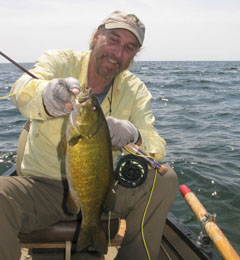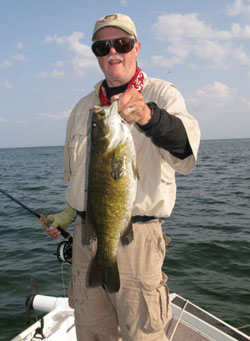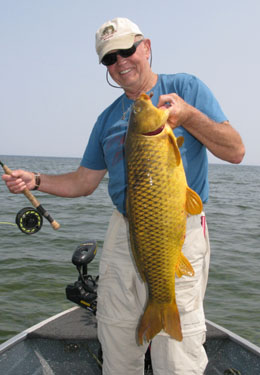
When the wind is down, even small craft like a canoe can work on Lake Michigan
North America’s largest bodies of water, the Great Lakes are difficult to imagine if you haven’t seen them. Like freshwater oceans, they encompass tens of millions of acres with far distant shorelines invisible to the eye. For smallie fans used to little meandering rivers, you might think a body of water like Lake Michigan sounds inhospitable and utterly unfishable. But you’d be wrong. I’ve been fishing smallmouth in Lake Michigan for 20-plus years, often in nothing bigger than a kayak or canoe and sometimes just by wading.
While Lake Michigan is the second largest of the Great Lakes, with 14 million acres and depths of hundreds of feet, it also has over 200,000 acres of extremely shallow water. Especially in areas of northern Wisconsin and northern Michigan, the lake has vast flats that seem like they should be in the Florida Keys.
You can be a half-mile from shore, look down and see bottom barely 5 feet below you. In the crystalline waters of these shallow flats, every rock and pebble is visible and so are the fish. Yes, fish– huge smallmouth, giant carp and big drum all cruise these flats and you’ll often see them swim by.
The Great Lake by Canoe

Plenty of huge smallmouth like this one roam the shallow flats of Lake Michigan
For example, a couple summers ago my friend Todd and I were fishing the lake near Escanaba on Michigan’s Upper Peninsula. With only a canoe and oars we couldn’t travel far, but that wasn’t a problem. We rowed a few hundred yards down the shore and started working patches of rubble/gravel. The predominant substrate along these shallow shorelines is clean sand, but in the sunshine it was easy to spot the hard-bottom areas. We got into some smallmouth after only 30 minutes, but it was a pod of smaller ones mostly under 12 inches. Upping the anchor and rowing 50 yards to try new water, we spent another 90 minutes fishing a very shallow rocky area just 3 to 4 feet deep. We found willing fish nearly every time we stopped, but they continued to run small.
We had been fishing about 400 yards from shore, so decided to more a little farther out. Now we were a full 600 yards from the shoreline, but water was still only 4 to 5 feet deep. But that did the trick. Todd in the front of the canoe with his spinning rod was using a Super Do (a small thin-profiled tube jig). In just a few casts, a fish struck that put a serious bend in the rod. After a couple jumps and strong runs, a fat 16-incher came to hand. Todd unhooks fish fast, and it seemed that almost instantly his lure was back in the water and another fish was on. And right after that one, yet another dandy. It was obvious we had found good fish. All I needed to do was find a fly they wanted.
Switching from black to white then to a yellow Hare, I, too, hooked a big fish. And for the next 3 hours both Todd and I were into fish. Sometimes we had two on at once and had to take turns using the net. The bite might slow in one spot after half a dozen fish, so we would lift anchor and move by drifting and rowing. Often as we slowly moved we would spot a fish swimming ahead of the canoe. While I was lowering the anchor, Todd would make the first cast and he’d have another 14- to 17-incher on before the anchor hit bottom. Then I’d launch my yellow Hare and I’d have one, too. By the time we lifted anchor for the last time and headed to shore, we had landed at least 67 smallmouth, with many of them 16-inchers. Not bad for never getting more than a mile from our starting point.
Lake Michigan By Boat
Here’s another Lake Michigan experience that took place just last summer. My friend Dan and I were fishing north of Green Bay, Wisconsin, in a 16-foot boat. A surface chop made for a bouncy ride as we headed to some rocky flats a few miles from the landing. But the August weather was warm, so a few splashes weren’t a big deal. The area we targeted was several hundred yards from shore, but no more than 6 feet deep, with some places barely 3 feet. These rocky flats were also good-sized, perhaps 75 acres in total. Besides gravel and rubble substrates, there were also 3-foot-diameter boulders scattered across the flats.

Dan Johnson with a giant carp. These fish are visible in the clear, shallow water
A south wind was blowing at 15 miles an hour, so after dropping anchor we would both cast our flies downwind, rather than trying crosswind or against-the-wind casts. We had a trolling motor, but because we made our first stop on the upwind edge of the rocky area, all we needed to do to move was lift the anchor a little off the bottom and the wind would push us 40 feet and we could re-anchor.
We didn’t find active fish the first couple of stops, but in the third spot something nearly tore the rod out of my hands. True, my hands were wet, since I had just washed them after eating an orange, but this baby had power– too much power. Line quickly peeled off the reel and I was soon down into the backing. I yelped for Dan to follow the fish and he immediately raised anchor and went after the unseen bruiser with the electric motor. The fight was long and I was pretty sure what it was before I saw it. Finally a huge golden-scaled carp came to the boat that filled the net and exceeded 17 pounds on the scale.
That was exciting, but just a warm-up. Now the bronze beauties took their turn. Using a fast retrieve with small brownish-colored Clouser-Minnow-style streamers, we hooked (and sometimes lost) big smallmouth for another 4 hours. Eighteen, 19, even a 20-incher, one big bronzeback after another nailed our flies. Sometimes we saw fish swim by and they would turn and strike our fly if it was close enough. Other times we would cast towards subsurface boulders 45 or 50 feet downwind and a fish would hit. It was “just” a 26 fish day, but almost all were dandy smallies over 16 inches, plus another big carp and a five-pound drum.
By the way, on both these beautiful summer days, we never saw another angler. Lake Michigan has many off-the-radar areas like this with terrific smallmouth fishing. Along Wisconsin’s Door Peninsula there are thousands of acres of good water and plenty of big smallies. (Though this is a place you are likely to see some other anglers). A little farther north, 80,000-acre Big Bay de Noc has many fish, yet very few smallmouth fans. And along the northern coast of Lake Michigan near Manistique, there are many miles more of good water. No wonder I love this great lake for smallies on the fly!


No comments yet.